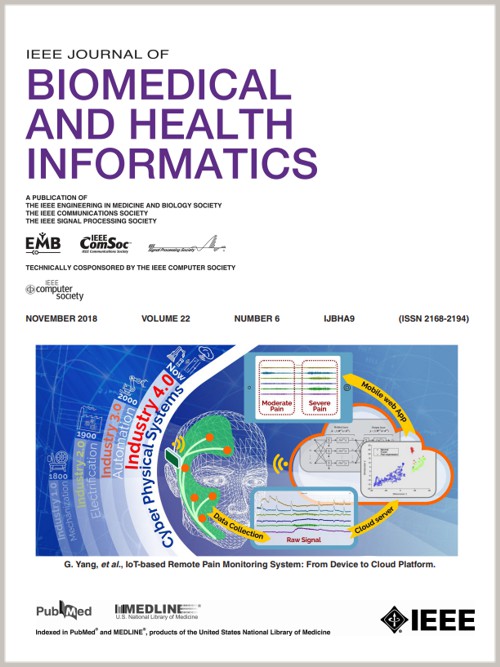血糖水平预测中的体育活动整合:不同层次的数据融合。
IF 6.7
2区 医学
Q1 COMPUTER SCIENCE, INFORMATION SYSTEMS
IEEE Journal of Biomedical and Health Informatics
Pub Date : 2024-10-21
DOI:10.1109/JBHI.2024.3483999
引用次数: 0
摘要
预测血糖水平(BGL)有助于更有效地管理 1 型糖尿病。体力活动(PA)是糖尿病管理的一个关键因素。它影响血糖水平,因此必须在血糖水平预测中有效利用体力活动,通过纳入这一关键因素来支持糖尿病管理系统。由于患者之间和患者内部的 PA 对血糖胆固醇的影响不稳定,加之知识不足,在血糖胆固醇预测中应用 PA 具有挑战性。因此,需要将 PA 与 BGL 融合的最佳方法来提高 BGL 预测的性能。针对这一差距,我们提出了从 PA 数据中提取信息并将其整合到 BGL 预测中的新方法。本文通过开发从 PA 数据中提取信息并将这些信息与 BGL 数据在信号、特征和决策层面进行融合的不同方法,提出了几种新型 PA 信息预测模型,以找到在 BGL 预测模型中部署 PA 的最佳方法。在信号级融合方面,将不同的自动记录 PA 数据与 BGL 数据进行融合。此外,还为特征级融合开发了三种特征工程方法:PA 的主观评估、PA 的客观评估和 PA 的统计。此外,在决策级融合中,采用了集合学习的方法,将不同输入训练的模型的预测结果结合起来。然后,对已开发的 PA 信息方法和无融合方法以及它们之间进行了比较研究。分析在公开的俄亥俄州数据集上进行,并进行了严格的评估。结果表明,采用 PA 可以在统计上显著提高 BGL 预测性能。结果表明,从统计学角度看,部署 PA 可以显著提高 BGL 预测性能。此外,在已开发的利用 PA 进行 BGL 预测的方法中,信号级心率数据和特征级 PA 强度类别与 BGL 数据的融合是最有效的方法。我们开发的方法有助于确定最佳方法,包括 PA 信息的种类和融合方法,从而有效提高 BGL 预测的性能。本文章由计算机程序翻译,如有差异,请以英文原文为准。
Physical Activity Integration in Blood Glucose Level Prediction: Different Levels of Data Fusion
Blood glucose level (BGL) prediction contributes to more effective management of diabetes. Physical activity (PA), which affects BGL, is a crucial factor in diabetes management. Due to the erratic nature of PA's impact on BGL inter- and intra-patients, deploying PA in BGL prediction is challenging. Hence, it is crucial to discover optimal approaches for utilising PA to improve the performance of BGL prediction. This work contributes to this gap by proposing several PA-informed BGL prediction models. Different approaches are developed to extract information from PA data and integrate this information with BGL data at signal, feature, and decision levels. For signal-level fusion, different automatically-recorded PA data are fused with BGL data. Also, three feature engineering approaches are developed for feature-level fusion: subjective assessments of PA, objective assessments of PA, and statistics of PA. Furthermore, in decision-level fusion, ensemble learning is used to combine predictions from models trained with different inputs. Then, a comparative investigation is performed between the developed PA-informed approaches and the no-fusion approach, as well as between themselves. The analyses are performed on the publicly available Ohio dataset with rigorous evaluation. The results show that among the developed approaches, fusing heart rate data at the signal-level and PA intensity categories at the feature-level with BGL data are effective ways of deploying PA in BGL prediction.
求助全文
通过发布文献求助,成功后即可免费获取论文全文。
去求助
来源期刊

IEEE Journal of Biomedical and Health Informatics
COMPUTER SCIENCE, INFORMATION SYSTEMS-COMPUTER SCIENCE, INTERDISCIPLINARY APPLICATIONS
CiteScore
13.60
自引率
6.50%
发文量
1151
期刊介绍:
IEEE Journal of Biomedical and Health Informatics publishes original papers presenting recent advances where information and communication technologies intersect with health, healthcare, life sciences, and biomedicine. Topics include acquisition, transmission, storage, retrieval, management, and analysis of biomedical and health information. The journal covers applications of information technologies in healthcare, patient monitoring, preventive care, early disease diagnosis, therapy discovery, and personalized treatment protocols. It explores electronic medical and health records, clinical information systems, decision support systems, medical and biological imaging informatics, wearable systems, body area/sensor networks, and more. Integration-related topics like interoperability, evidence-based medicine, and secure patient data are also addressed.
 求助内容:
求助内容: 应助结果提醒方式:
应助结果提醒方式:


